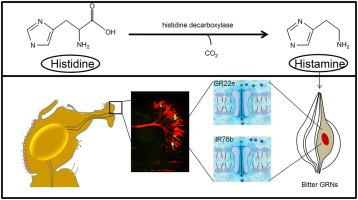Insect Biochemistry and Molecular Biology ( IF 3.8 ) Pub Date : 2021-05-13 , DOI: 10.1016/j.ibmb.2021.103586 Binod Aryal 1 , Youngseok Lee 2

|
Many foods and drinks contain histamine; however, the mechanisms that drive histamine taste perception have not yet been investigated. Here, we use a simple model organism, Drosophila melanogaster, to dissect the molecular sensors required to taste histamine. We first investigated histidine and histamine taste perception by performing a binary food choice assay and electrophysiology to identify essential sensilla for histamine sensing in the labellum. Histamine was found to activate S-type sensilla, which harbor bitter-sensing gustatory receptor neurons. Moreover, unbiased genetic screening for chemoreceptors revealed that a gustatory receptor, GR22e and an ionotropic receptor, IR76b are required for histamine sensing. Ectopic expression of GR22e was sufficient to induce a response in I-type sensilla, which normally do not respond to histamine. Taken together, our findings provide new insights into the mechanisms by which insects discriminate between the toxic histamine and beneficial histidine via their taste receptors.
中文翻译:

黑腹果蝇的组胺味觉厌恶
许多食物和饮料都含有组胺;然而,尚未研究驱动组胺味觉的机制。在这里,我们使用一个简单的模式生物黑腹果蝇来剖析品尝组胺所需的分子传感器。通过执行二进制食物的选择法和我们第一调查组氨酸和组胺味觉电为了识别必要的感受器对组胺的唇瓣感。组胺被发现激活 S 型感受器,其中包含苦味味觉受体神经元。此外,对化学感受器的无偏见遗传筛选显示,组胺感应需要味觉受体 GR22e 和离子型受体IR76b。异位表达GR22e 足以在 I 型感觉器中诱导反应,而 I 型感觉器通常对组胺没有反应。总之,我们的发现为昆虫通过味觉受体区分有毒组胺和有益组氨酸的机制提供了新的见解。



























 京公网安备 11010802027423号
京公网安备 11010802027423号